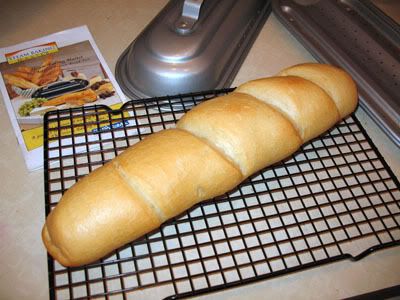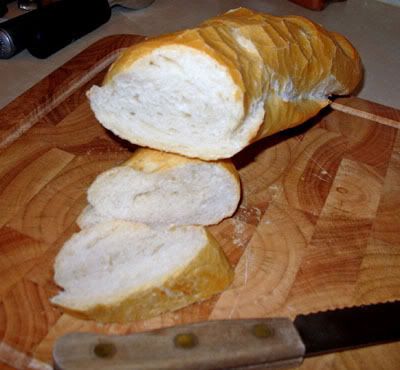
Steam Baking Master French Bread Pan

I found this pan on ebay - it makes pretty darn good french bread.
Here's the loaf:

Not a very good picture of the crumb here...no natural light today (it's cold and cloudy here).

Trish


I found this pan on ebay - it makes pretty darn good french bread.
Here's the loaf:

Not a very good picture of the crumb here...no natural light today (it's cold and cloudy here).

Trish

For Thanksgiving weekend, we've got guests for the first time in years. When we lived in Boston, Aurora and I decided after a couple of years traveling to Atlanta for Thanksgiving that it's just too much to hop on a plane. Flying on the Wednesday before Thanksgiving sucks rocks, and both of us always have to work that day, so we had to rush to the airport in the evening holiday traffic. Then we spend just a few short days before rushing back home on Sunday, hoping our flights don't get canceled or delayed, leaving us marooned in some strange city and missing a day of work.
But now that we're in Oregon, family is (relatively) close by, and so her father, his wife and Aurora's grandmother all came up from Southern Oregon to spend the weekend.
Aurora's grandmother grew up in Oregon, but shortly after she graduated high school (in the 30s), she headed east to NYC to pursue a career as an actor. There, she fell in love with what her local bakery called "Sour Corn Rye." It was dense, had caraway, and clearly contained a high percentage of sourdough rye.
I've played around with rye, but didn't feel entirely comfortable making a rye with more than 50% rye flour for the meal. So, instead, I made a 40% caraway rye that mostly followed the recipe in Hammelman's Bread, which has got to be the most useful and comprehensive bread baking book I've ever seen. And that's coming from a guy who bakes 90% of his breads from 100% whole grains. Hammelman never exceeds more than 50% whole grains unless it's a rye (and the rye section is especially good -- Hammelman has a particular passion for German ryes), but the techniques are applicable to just about any bread.
Anyway, about the rye. The first loaf I made a couple of days ago was at 68% hydration, and, though it was delicious, it wasn't as open a crumb as I'd have liked. So for the holiday bread, I increased the water to 75%. I also keep my rye sourdough at 100% hydration, rather than the eighty-something that Hammelman uses, simply because it's easier for me. I did follow Hammelman and add instant yeast, however, since the oven would otherwise be occupied with a massive turkey in the afternoon -- I needed to bake in the morning. Recipe and percentages are below:
Formula
Ingredients for one loaf
Again, I was in a bit of a hurry, so after mixing all the ingredients together, I kneaded it for 5-10 minutes until it would windowpane. This was a pretty sticky business, and it wasn't the most pleasant kneading, but with a dough scraper nearby and damp hands, it was tolerable. I then shaped it into a ball and put the dough bucket in my picnic cooler on an upturned bowl. After throwing a cup of boiling water in the bottom, I closed it and didn't open it back up for about 90 minutes. It generally stays about 80-85 degrees in the cooler. I then preshaped the dough, let it rest 15 minutes and shaped it into a batard.
After shaping, I wrapped it in baker's linen that I'd dusted with rice flour (the best stuff in the world for dusting surfaces that will hold sticky doughs) and put it back into my makeshift proof box for anotherr 90 minutes. Then, 45 minutes on a hot stone with steam at 450 degrees F and an hour's cooling.
Great with leftover roast turkey, strong mustard and whatever other fixings you can dig up.
I've just put another loaf in the oven, this time a long-fermentation 60-40 whole wheat-white wheat batard, and it's a cold oven bake. I'll post it later tonight or tomorrow. Hope it goes well with tonight's turkey soup ....

These small baguettes are made with semolina flour. They weren't supposed to have pine nuts but I ran out of currants and had to improvise. It turns out the pine nuts were pretty good.
The recipe for the bread is here.
susanfnp

My wife loves pumpkin and so I'd been having this idea of making some kind of pumpkin bread, but I wasn't sure what recipe. Yesterday I happened to pick up Maggie Glezer's "A Blessing of Bread" and found, on page 178 the recipe for "Pan de Calabaza", a sephardic pumpkin bread. Looked good so I decided to make that. After thinking for a while what shape I would make it (3-braid, 4-braid, loaf etc.) I decided to try something different.
 Double Pumpkin Bread
Double Pumpkin Bread
I call it "Double" pumpkin bread because it contains pumpkin, and looks like one.
Recipe (as computed from the original using my spreadsheet:
This makes 2 pounds of a 44.45% hydration dough, although I found myself adding just a teeny bit of water. Makes a large loaf, two small to medium loaves, or 1 loaf and a few rolls.
The taste was delicious, with the spices noticeable, but subtle. Fine textured crumb, soft crust and very moist inside. Worked well with pumpkin soup and everybody at our Halloween party loved it (and the three pizza's I made!) In case you are wondering: I kept the teeth light by covering them with an aluminum foil cutout after about 10 minutes of baking.

My mother has asked me to bake some bread for her Episcopal Church’s communion during the Christmas Mass. The Church is in (very) rural South Georgia, and only has 75 or so members all combined. (Episcopalians are kind of a rare breed down there). I am very honored to have been asked, because although this may be the smallest church in her town, it is by far the most worldly and savvy. These people travel to Israel, Rome, and all over.
So anyway, I am really looking to bake for them a bread that is as historically and anthropologically close to the bread that Jesus would have served at the last super. Even if you are not a Christian, or find that whole story ridiculous, I am looking for bread that would have been in that part of the world at that time. I don’t think AP flour was around. I know that Durum wheat was domesticated before the soft, red, spring, and winter wheat that we use in modern flours. Anyone got any tips?
These people are the Doctors and Judges of the town, and they will know B.S. if I try to pass off Turkish flat bread, or a whole wheat pita as bread from the last supper.
Thanks for you help guys. I LOVE this site!!!

Can one make bread with Durham wheat. Have any of you tried it? I think it may make for chewy crumb.
Thanks


Crusty Italian
I wanted to try one of Mariana's recipes from her Journal and use the Food Processor to knead the dough. I followed her write up including the 30 seconds kneading with the steel blade. I was skeptical that this would work but I'll try anything once! I have to say I am surprised that the gluten came together so quickly. The bread baked well and the family liked the size of the loaf for a free form. The crumb is even and creamy color with a very nice flavor.
I enjoyed this as a yeasted recipe so I thought I would use this recipe as a base and add the herbs and liquor from Floyds "Pain De Provence" and do it as a sourdough sponge. I'll post that later if I can manage a decent slash.
I post the recipe with my changes below but it's really from Mariana.
Eric
Crusty Italian Loaf
Sponge Starter
(12oz)
6.5 oz unbleached all-purpose flour
5.5 oz water
1/8 tsp active dry yeast
Let it ferment at room temperature until triples in volume and begins to recede, 6-8 hours. Use it before it collapses too much.
Dough
1 lb unbleached all-purpose flour
12 oz sponge starter
3/4 tsp Instant yeast
1Tbsp kosher salt
1 1/4 cup water (cool)
Mix everything and let it rest for 15 min. Knead for 5 min (I kneaded for 30 sec in a food processor).
Bulk fermentation: 1 hr at room temperature, then at least for 8 hours in refrigerator to develop flavor, then 2 more hours at room temp.
Proof: 1 hour at room temperature
Bake, steamed, on a preheated baking stone for 10 min at 475F, then 15 more min at 450F. Turn off the oven and let them finish baking for 10 more minutes. The crust should be medium to dark brown. If the crust is not brown enough, the loaves will soften as they cool.
To properly steam these loaves, mist from a plant sprayer prior to baking, then 2 more times during the first 10 min of baking.

My first question concerns buttermilk & vitamin C. These both acidify the dough, which gives the yeast a boost. Does the buttermilk do anything else - or anything different than regular milk?

I've been scouring the internet for weeks now, looking for authentic recipes from Spain. I have a presentation coming up for my Spanish class, and wanted to wow my peers with something exciting. Now, while I realize that Spain isn't exactly the yeasted-bread capital of the world, I refuse to believe that generations of culinary achievement have only produced a few questionable recipes of Pan de Muerto (the only recipe my searching turned up.) Does anyone have bread recipes that reflect some of Spain's wonderful culture and cuisine? Any background information you can give on recipes would also be appreciated, even if you just suggest a book to look up. Bonus points go to anyone who posts in Spanish. (I could use the practice. :) )

I used to make these bread sticks all the time, before I knew how to make bread. My husband put in a request for them last week, and it reminded me how good they are, and a snap to make.
Also fun if you have little ones who love to roll dough snakes.
Recipe here.